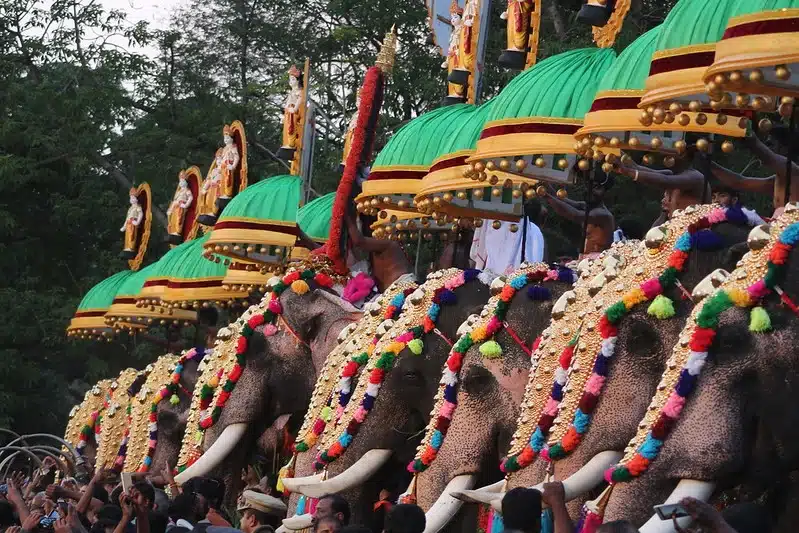There is something truly magical about gems. My journey, however, didn’t begin with me gazing at jewels alone. It started with the stories my beloved grandmother used to share. She undeniably loved diamonds, firmly believing they were a girl’s best friend. Growing up in Surat, she would often recount how her surroundings had heightened her affinity for diamonds. As a child, I would sit in rapt attention as she spoke of the diamonds in Surat, where she claimed that even the most renowned gems from around the world paled in comparison. She would lovingly bring out her diamond set gifted by her father, regaling me with tales of how it was meticulously crafted in the Surat Diamond Market.
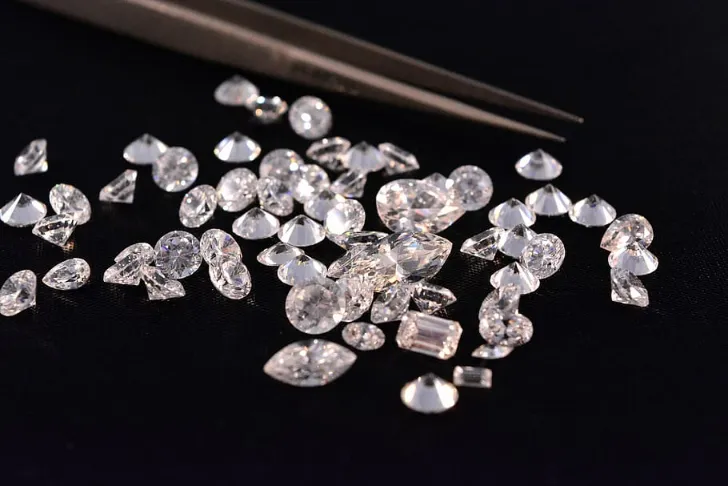
My grandmother’s stories resonated with me profoundly, and I always harboured a deep desire to visit this place that had enchanted her, as well as so many others, over the years. And so, I packed my bags, leaving Kerala behind, and journeyed to Gujarat, the land of my grandmother’s stories and the home of the Surat Diamond Market.
Surat, the ‘Diamond City’ by the Tapi River in Gujarat, is the epicenter of the global diamond industry, giving life to 90 per cent of the world’s natural diamonds. Touching down in Surat felt like a dream turned into reality. The city seamlessly blends tradition with modernity, offering a unique cultural experience. With no clear transportation plan, a friend’s recommendation of Savaari saved my time and delivered a reliable way to explore. Booking a Savaari car with a chauffeur instantly put me at ease. Also it connected me with a knowledgeable local driver, Sunil, who’d become an essential part of my Surat journey.
Diamond dreams and timeless memories – A tale to treasure
I learned that Surat today is a central hub in a thriving industry with an annual turnover of $24 billion. A significant part of this success story can be attributed to the dedication and craftsmanship of over 700,000 workers in 6,000 polishing units. Together, they process nearly 95% of the world’s diamonds. But it has a history associated with it, which was imparted to me by Sunil.
The landscape gradually transformed around us as we were on our way to the bustling diamond market. Surat’s scenic beauty unfolded with lush green fields and meandering rivers, painting a picturesque backdrop for our adventure. People spoke a form of Gujarati a little different from what I was familiar with. Sunil then told me that the dialect is the colloquial form spoken in Surat, which I learned more about by reading this blog.
He then began to narrate the tale of Surat’s rise to prominence. Surat was a place where history and innovation waltzed together, a vibrant tapestry of tradition and modernity. However, the true gem of Surat’s narrative was its evolution into a diamond processing powerhouse—a tale that had unfurled relatively recently, spanning less than a century.
Diamond crafting – Surat’s artisanal journey
Surat’s journey began in the early 1900s when a local visionary dared to import skilled diamond cutters from East Africa, marking the genesis of the city’s diamond polishing industry. However, what made it prosper was the work of a family.
Journeying through time – Surat’s diamond crafting tale
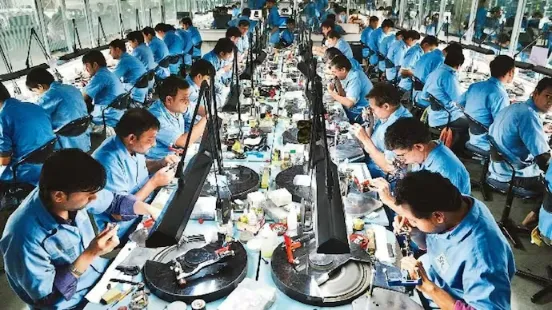
The anecdotes flowed freely as he shared his memories of those early days—of watching in awe as the city’s artisans meticulously honed their craft, coaxing brilliance from the heart of uncut gems. His voice brimmed with nostalgia as he painted a vivid picture of the 1960s when the enterprising Patel community set the diamond industry ablaze. With animated gestures, he described how they boldly imported rough diamonds and skillfully exported polished ones, sculpting Surat’s destiny into the diamond capital of India.
With each word, it felt as if we were traversing the city’s streets and the annals of time itself. His storytelling was imbued with the vivacity of someone who had lived and breathed the city’s history, turning our journey into an enchanting ride through Surat’s past and present.
From dust to diamonds – Craftsmanship chronicles
Soon, my destination arrived. Sunil was overly enthusiastic because I was paying rapt attention, and decided to introduce me to his friend, an acclaimed diamond craftsman. I found myself standing outside a small, unassuming workshop tucked away in a quiet corner of the market. Inside, I saw a skilled artisan, who was later introduced to me by Sunil as Rajesh, who was meticulously examining a rough diamond through a magnifying glass.
Curiosity brimming, I asked Rajesh about his journey into the mesmerizing world of diamond craftsmanship. He said his journey began in 1995 when he joined his father in the extraordinary world of diamonds. Rajesh’s father was a renowned artisan in Surat, known for his exceptional craftsmanship, and young Rajesh grew up watching him work his magic.

He reflected on his early days when it was about learning the basics, understanding the nuances of each facet, and honing his skills. Over time, he had the privilege of working with some of the most experienced artisans in Surat. His journey had been one of continuous learning and growth. Eager to delve deeper into his craft, I inquired about the types of diamonds that captured his attention and craftsmanship. With a proud smile, Rajesh shared that he specialized in crafting exquisite solitaire diamonds that captured hearts with their brilliance and elegance. It was a labour of love, he emphasized.
The heart of Surat – Where diamonds and heritage meet
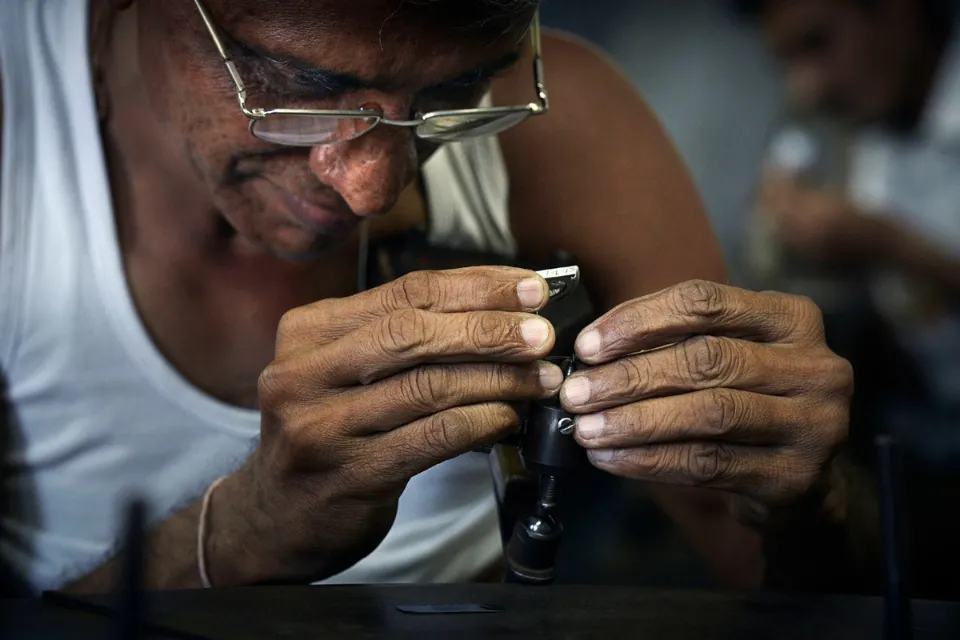
My gaze wandered to the bustling market outside, and I couldn’t help but wonder about the culture and lifestyle unique to Surat’s diamond market. I was told that Surat’s diamond market wasn’t just a place of commerce; it was where tradition and innovation danced hand in hand. The work was steeped in tradition, passed down through generations, even as they embraced cutting-edge technology to enhance their craft.
His gaze then drifted to a black-and-white photo on the workshop wall, and he revealed that his family had been a part of this world for generations. His grandfather, in particular, had not only been a skilled artisan but had also had the honor of crafting diamonds for Maharaja Pratap Singh Rao Gaekwad of the Gaekwad dynasty. The stories of their forefathers, their dedication to their craft, and the legacy they left behind were all woven into the fabric of the Surat Diamond Market.
From rough to radiant – The art of diamond manufacturing
After soaking in that history, I was eager to learn more about the intricate steps involved in diamond manufacturing. Rajesh promised to walk me through each process step, from planning to polishing. This was the place where diamonds, in their raw and unassuming form, underwent a remarkable transformation into dazzling gems. Rajesh, the skilled artisan, welcomed me warmly and invited me to sit beside him as he began to unveil the intricate steps of diamond manufacturing. If you are curious about the art of diamond manufacturing, I highly recommend making a pit stop at a diamond manufacturing workshop in the Mumbai to Delhi leg of your golden quadrilateral road trip.
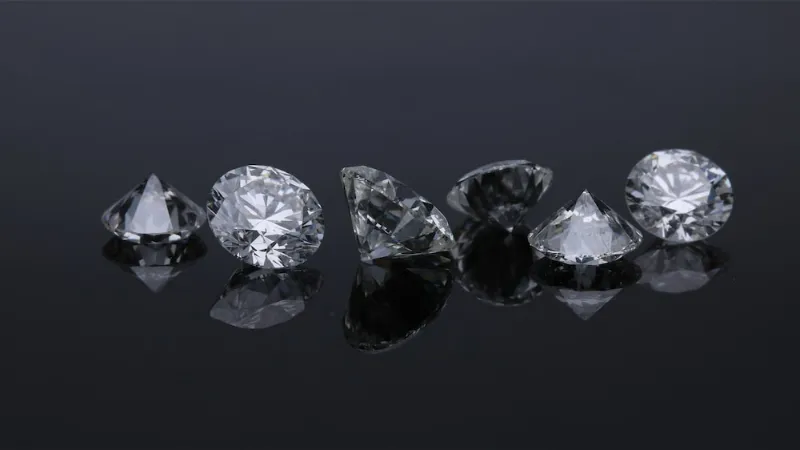
Step 1 – Planning the cut
The journey of a diamond begins with meticulous planning. It’s a complex process that blends the artistry of skilled artisans with cutting-edge technology. Rajesh introduced me to the Sarin machine, a remarkable tool pivotal in this phase. It’s used for precise measurements and for creating 3D models of rough stone. I learned that choosing the right diamond shape is crucial, as it not only maximizes the yield but also minimizes waste. This planning phase can stretch over several months, highlighting the delicate balance between traditional craftsmanship and modern technology.
Step 2 – Marking the diamond
In the next stage, Rajesh explained the importance of marking the diamond. Here, advanced 3D laser technology comes into play. The precision of this process is paramount because even the tiniest error can significantly impact the final gem’s quality. I observed as Rajesh demonstrated how diamond markers use this technology to mark the stone precisely. They must possess a keen eye for identifying imperfections and deciding how to work around them strategically, ensuring the highest possible clarity.
Step 3 – Cleaving and sawing
Sawing, the third step in the diamond manufacturing process, involves splitting the raw diamond into distinct sections. These sections will eventually become individual finished diamonds. Rajesh explained the methods employed during this phase. I learned that both blades and lasers can be used for sawing, each with unique advantages. Blades, coated with precision diamond grit, offer minimal cutting loss, while laser sawing provides an elevated level of precision and accuracy, making it ideal for intricate work.
Step 4 – Blocking and bruting
With the rough diamond divided into sections, it’s time for blocking and bruting. This is where the diamond begins to take on its basic shape. Rajesh described the techniques involved, including laser bruting, diamond-on-diamond friction, and diamond dust-coated disks. It’s a skilful process that requires finesse and precision, as abrasion is used to create the diamond’s curved edges.
Step 5 – Polishing
The final step in the journey is polishing, where the true brilliance of the diamond is revealed. Rajesh shared that this involves shaping the facets to perfection to optimize the reflection and refraction of white light, resulting in the diamond’s characteristic sparkle and scintillation. As Rajesh walked me through each step, I couldn’t help but be captivated by the artistry and precision that went into every facet of diamond manufacturing. It was a mesmerizing journey into the heart of Surat’s diamond craftsmanship, one that left me with a newfound appreciation for these dazzling gems.
Step 6 – Certification and grading
After polishing, each diamond undergoes a meticulous examination. This involves using a laser scanner and the scrutiny of a skilled gemologist. Diamonds not meeting quality standards receive further polishing. Subsequently, they are sent to renowned grading labs like GIA and IGI for certification. This ensures the diamond’s authenticity and provides comprehensive quality information.
These exquisite diamonds are ready to adorn stunning jewellery pieces. Rajesh and I exchanged warm farewells as the day transitioned into the evening. I left his workshop with newfound knowledge and a profound appreciation for the artistry and dedication that bring these gems to life.
Surat diamond market – Where tradition meets technology
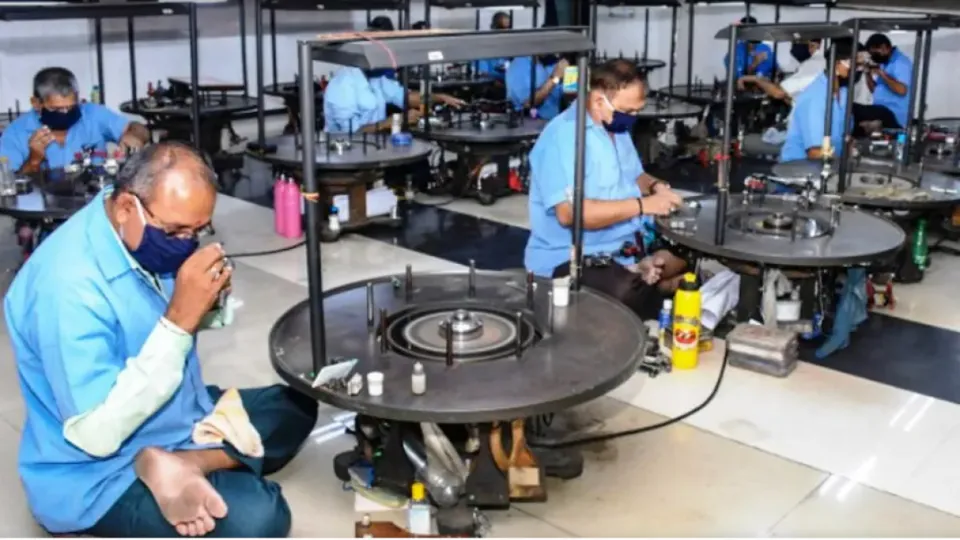
I delved deeper into the heart of Surat’s diamond market and uncovered an extraordinary blend of tradition and technology that left me in awe. Nestled in a quiet corner, a workshop beckoned me with the promise of captivating discoveries. What I found inside exceeded all expectations.
Within the workshop’s confines, the worlds of age-old craftsmanship and modern precision machinery converged to shape the future diamonds. An encounter with Anil, one of the facility’s skilled technicians, brought to light the remarkable fusion of artistry and cutting-edge technology that defined Surat’s diamond industry.
Advanced technology to enhance the craft
Anil’s passion for the craft was palpable as he unveiled the intricate workings of these machines, driven by advanced computer-aided design (CAD) software. These digital marvels meticulously charted the optimal cuts for each diamond, minimizing waste while enhancing the gem’s brilliance. Laser-cutting machines, guided by these precise digital blueprints, sculpted the diamonds with unparalleled accuracy.
But the technological developments didn’t end there. Anil led me to another facility section where quality control took center stage. Here, specialized scanners and detectors painstakingly examined every facet, leaving no room for imperfections to escape detection. It was a process that ensured only the most flawless diamonds would find their way into the global market.
At that moment, I felt an even deeper connection to these gems that had fascinated me since childhood. Surat’s diamond industry, rooted in tradition, had seamlessly embraced innovation to meet the ever-evolving demands of a rapidly changing world.
Surat’s path to prosperity – Nurturing lives and livelihoods
One remarkable aspect that struck me during my interactions with the people of Surat was how the diamond industry had transformed lives. The economic impact of this thriving market had not only elevated individuals but also uplifted the entire city.
Diamonds – Shaping livelihoods and dreams
I conversed with artisans, traders, and shopkeepers, and it became clear that the diamond industry was not just about gleaming stones but about livelihoods. Many locals had found employment opportunities within the diamond trade, whether as skilled cutters and polishers, traders, or support staff. This industry has brought prosperity to countless families, providing stable income and a chance for upward mobility. These jobs are not just a source of income; they represent dreams realized, children educated, and a brighter future.
A ray of hope behind bars – Transforming lives through diamonds
While exploring Surat, I stumbled upon a heartwarming initiative within Lajpore Central Jail. Here, inmates are offered a unique opportunity: diamond cutting and polishing training. This program, involving eight inmates, equips them with valuable skills for a better future. Inside the prison, two polishing wheels serve as tools of change, guided by an experienced diamond cutter and fellow inmates with expertise.
What truly moved me was the provision of a diamond to each trainee, symbolizing hope and transformation. These diamonds are securely kept in the prison until they complete the cutting and polishing process. It’s not just about acquiring skills; it’s about rewriting lives and igniting fresh beginnings. This initiative shines as a beacon of hope, proving that the human spirit can prevail even in the most challenging circumstances.
Diamonds transforming lives – Surat’s thriving industry
The economic benefits were not confined to individuals alone; they extended to the city. Over time, many diamond traders and exporters established workshops in Surat and built skilled teams to craft valuable diamonds expertly. Today, Surat is a central hub in a thriving industry with an annual turnover of $24 billion. A significant part of this success story can be attributed to the dedication and craftsmanship of over 700,000 workers in 6,000 polishing units.
Together, they process nearly 95% of the world’s diamonds. Surat’s impressive achievements are due to the hard work and commitment of its artisans, business owners, and jewelers, all striving to maximize the beauty of each diamond.
The Surat diamond bourse – A world trade arena

When I thought of a trading center, my mind naturally drifted to places like Mumbai’s BKC Building. In a similar vein, Sunil shared how Surat had established its own diamond trading centre, called the Surat Diamond Bourse further highlighting the city’s economic dynamism. It spans an astonishing 7.1 million square feet across 35 acres, surpassing even the US Pentagon as the world’s largest office building.
He guided me to a colossal structure that loomed ahead as we stood in its impressive shadow. It symbolizes the city’s unwavering commitment to the diamond industry.” With pride in his voice, he shared its remarkable specifications. As we approached the entrance, Mr. Rajesh continued, “Scheduled to open this November, it will host over 65,000 diamond professionals, invigorating Surat’s economy and creating countless job opportunities. Be sure to book a reliable taxi to the bourse to witness the grandeur for yourself. But it’s not just about its size; it’s a lifeline for our diamond traders, offering state-of-the-art facilities and 131 elevators connecting the community.”
He explained the building’s eco-friendly design, emphasizing, “It’s a shining example of sustainability, utilizing natural ventilation and harnessing solar energy. It consumes 50% less energy than the maximum permitted, earning a prestigious ‘platinum’ rating from the Indian Green Building Council.”
I couldn’t help but appreciate how this day had unfolded. From savoring the flavors of Surat’s cuisine to standing before this architectural marvel, it was a journey filled with surprises and wonder. And it left me eagerly anticipating the bright future that awaited this diamond-studded city.
How to visit the Surat diamond market
By air
The nearest major airport to Surat is Surat International Airport. It is approximately 17.5 kilometers away from the Surat diamond market. From the airport, you can hire a Savaari taxi or reach the Surat diamond market.
By train
Surat has a railway station, which is well-connected to major cities like Mumbai, Ahmedabad etc. The Surat diamond market is only one Kilometer away from the Surat diamond market.
By car
Surat is well connected to major cities like Mumbai and Ahmedabad. If you are planning a road trip to Surat, book a Savaari cab from Ahmedabad for a comfortable journey.
Why visit the Surat diamond market?
Saying goodbye to Surat means carrying with me the luminance of this city, a reminder that dreams, when nurtured with passion and unwavering dedication, can truly become a reality. Surat’s legacy is a testament to the fact that once discovered, brilliance never fades away. It’s an invitation to embark on a journey where every gem holds a unique story, and every level is a shining testament to the indomitable spirit of the human heart.
But Surat is not just about its diamond market. After immersing ourselves in Surat’s diamond market’s rich history and promising present and future, Sunil suggested exploring some of the city’s culinary gems. The aroma of freshly prepared dishes wafted through the air, enticing us to take a seat. With his recommendations, we indulged in a feast of dhokla, locho, undhiyu, surti sev khamani, bhajiya. It was a hot day, So I indulged in a refreshing glass of Aam Panna, a quintessential Gujarati summer drink I read in this blog.
Every bite was a burst of flavours, a fusion of tradition and taste that mirrored the city itself. This is why I highly recommend downloading the Savaari car rental app. With just a tap, you can book your cab, which comes with a reliable chauffeur to take you around some of the best locations in India, its offbeat offerings and also its gastronomical delights. From the diamond glory to the local treasures, a road trip in Surat with Savaari is a journey full of surprises.
Last Updated on December 14, 2023 by Arathy Subhash Marath





